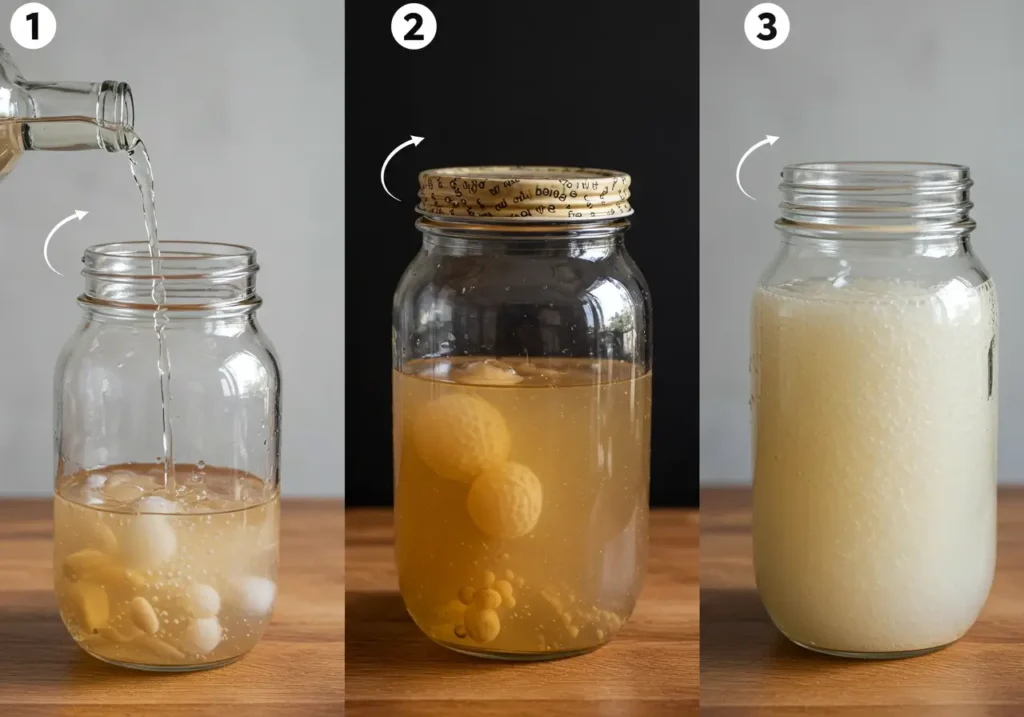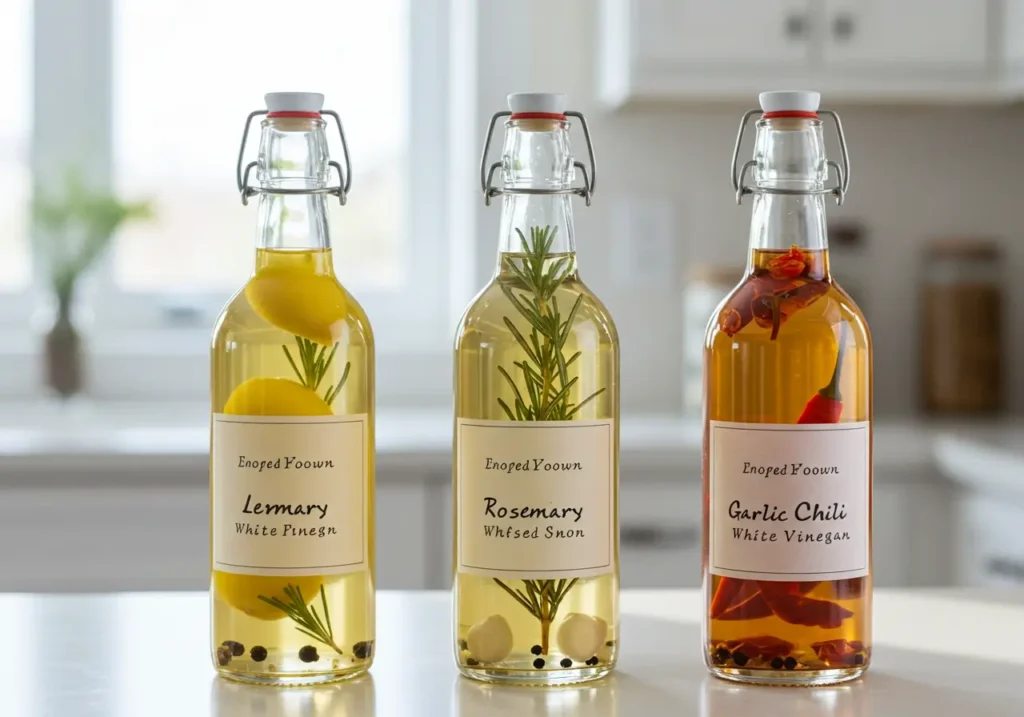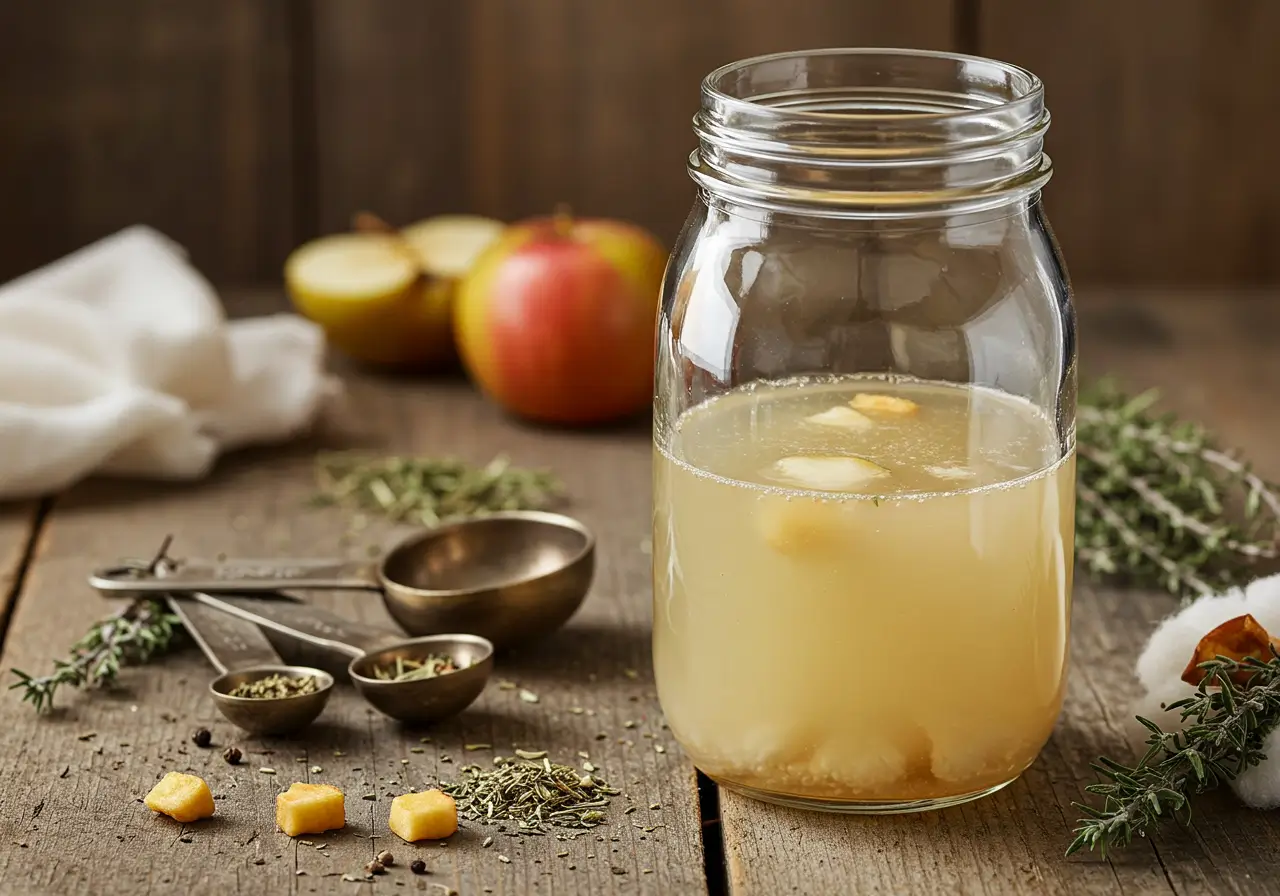Making white vinegar at home is a rewarding process that gives you control over purity, flavor, and purpose—whether it’s for cleaning, cooking, or preserving. This step-by-step guide will walk you through everything you need to know, from ingredients to storage and even troubleshooting.
With just a few ingredients and a bit of patience, you can create your own distilled white vinegar that rivals anything store-bought.
Table of Contents
What is White Vinegar?
White vinegar is a clear, acidic solution typically made from fermented grain alcohol (ethanol). It contains around 5% to 7% acetic acid, giving it a sharp, sour flavor and powerful cleaning properties. It differs from other types of vinegar—such as apple cider or balsamic—in clarity, flavor, and use.
Unlike other vinegars, white distilled vinegar is prized for its high acidity and neutrality, making it ideal for:
- Pickling and preserving
- Natural cleaning
- Odor control
- Disinfecting surfaces
You can also explore flavor variations and uses in flavored vinegar safety guidelines, particularly if you’re interested in infusions and scented options.
The Science Behind Vinegar Fermentation
Understanding how vinegar is made helps you control its quality. The process is a two-step fermentation:
- Alcoholic fermentation – Yeast converts sugar into ethanol (alcohol).
- Acetic acid fermentation – Acetobacter bacteria convert ethanol into acetic acid in the presence of oxygen.
This biological transformation results in the tangy, acidic liquid we call vinegar. The role of Acetobacter is crucial—it’s what turns your alcohol base into a usable, food-safe vinegar. For more detail, check out this overview from Britannica on how vinegar is made.
Ingredients and Tools You’ll Need
Before getting started, gather the following:
Ingredients:
- Distilled alcohol (vodka or grain alcohol)
- Water
- Raw vinegar or a Mother of Vinegar (starter culture)
Equipment:
- Glass jar or crock
- Cheesecloth or breathable lid
- Rubber band or string
- Funnel and strainer
- Dark, warm storage spot
Important: Always use non-reactive containers like glass, ceramic, or food-grade plastic.
Step-by-Step Guide: How to Make White Vinegar

Here’s how to start your own fermentation project:
1. Prepare the Alcohol Base
- Mix 1 part alcohol with 2 parts water to dilute the alcohol to approximately 5–10%.
- Pour the mixture into a sterilized glass jar.
2. Add Your Vinegar Starter
- Add ¼ part raw vinegar or a vinegar mother.
- This jump-starts the fermentation process with active acetic acid bacteria.
3. Cover and Store
- Cover the jar with cheesecloth.
- Secure with a rubber band.
- Place it in a dark, warm area (ideally 60–80°F).
4. Monitor the Fermentation
- Stir gently once a week.
- After 3–4 weeks, begin taste testing for acidity.
- Fermentation usually completes in 6–8 weeks.
5. Strain and Bottle
- Once it tastes sour and tangy, strain out solids.
- Transfer to clean bottles and seal tightly.
Troubleshooting & Common Mistakes
Even experienced vinegar makers hit snags. Here’s what to look out for:
- Mold or bad smells – Contamination; discard and sterilize everything.
- Fermentation not starting – Starter may be inactive; try fresh vinegar.
- Weak or bland vinegar – Low alcohol content; make sure dilution was accurate.
- Cloudiness – Normal; caused by live bacteria or leftover mother.
Bottling, Storing, and Using Your Vinegar
Once your white vinegar is ready:
Storage Tips:
- Store in a cool, dark place.
- Use sterilized glass bottles.
- Homemade vinegar has an almost unlimited shelf life when sealed properly.
Common Uses:
- Cleaning: Mix with water to disinfect surfaces.
- Cooking: Pickles, marinades, salad dressings.
- Beauty & Home: Hair rinse, odor control, weed killer.
- Cooking: Pickles, marinades, salad dressings, and even baking. White vinegar can enhance certain baked goods by reacting with baking soda to help them rise. If you enjoy baking at home, try this Crumbl cookies recipe that pairs perfectly with simple pantry staples.
For a breakdown of alternative cleaning options and the difference between cleaning vinegar and standard types, see this guide on cleaning vinegar.
Infusing & Scenting: Go Beyond the Basics
Want to level up your vinegar? Try infusing it:
Flavored Vinegar Ideas:
- Lemon peel and rosemary
- Garlic and basil
- Raspberry and thyme
Scented Vinegar (for cleaning):
- Essential oils (like lavender, tea tree, or eucalyptus)
- Citrus peels for a fresh scent
Just be sure to follow safety guidelines when using food infusions or essential oils.
Safety Tips for Food-Grade Vinegar
- Aim for at least 4–5% acetic acid for safe food use.
- Test acidity using pH strips or a vinegar testing kit.
- Avoid metal containers—they may react with acetic acid.
- If using vinegar for food (e.g., pickling), test pH below 4.5.

FAQs: What People Also Ask
Can you make white vinegar without a mother?
Yes—use raw, unfiltered vinegar with live cultures as a substitute. It works similarly to a vinegar mother.
How long does it take to make white vinegar?
Typically 6 to 8 weeks. Warmer environments speed up fermentation.
Is homemade vinegar stronger than store-bought?
It depends on your alcohol dilution. Most homemade vinegar ends up in the 4–7% acetic acid range.
Can I use wine or beer instead of alcohol?
Yes, but the end result won’t be white vinegar. You’ll get wine or malt vinegar, which are darker and have different flavors.
Why is my vinegar cloudy?
Cloudiness is usually harmless—just sediment or bacterial culture remnants.
What’s the difference between white and distilled vinegar?
White vinegar and distilled vinegar are often used interchangeably. However, “distilled” technically refers to the purity and processing method.
Conclusion
Making How to Make White Vinegar at home is simple, sustainable, and cost-effective. By understanding the fermentation process, using the right ingredients, and practicing safe storage, you’ll have a fresh batch of high-quality vinegar ready in just a few weeks.
From pickling vegetables to shining windows, your DIY vinegar will be a household staple in no time.

How to Make White Vinegar at Home
Ingredients
2 cups distilled alcohol (vodka or grain alcohol)
4 cups filtered water
½ cup raw unfiltered vinegar or Mother of Vinegar
Instructions
- Step 1: Dilute the AlcoholMix 1 part alcohol with 2 parts filtered water to bring the alcohol content down to about 5–10%.Step 2: Add the Vinegar StarterPour the alcohol mixture into a sterilized glass jar. Add the raw vinegar or vinegar mother to start the fermentation process.Step 3: Cover and StoreCover the jar with a breathable material like cheesecloth. Store in a dark, warm place (60–80°F).Step 4: Stir and MonitorStir gently once a week. Start tasting after 4 weeks. The vinegar should be sharp and sour when ready.Step 5: Strain and BottleStrain out the mother or solids, then bottle your vinegar in clean glass containers for long-term storage.


